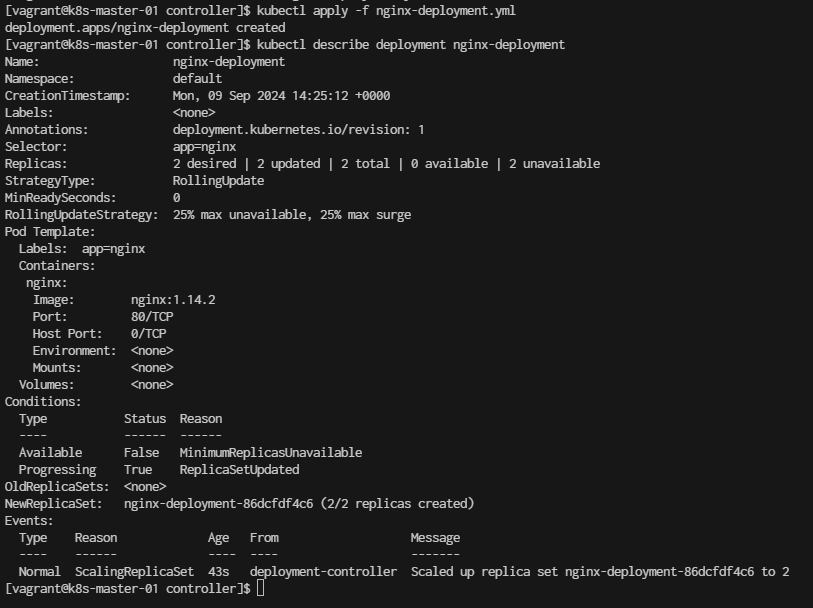Deploy first deployment
- Run on Master node
vagrant ssh k8s-master-01
create project folder
[vagrant@k8s-master-01 ~]$ mkdir controller
[vagrant@k8s-master-01 ~]$ cd controller
[vagrant@k8s-master-01 ~]$ vim nginx-deployment.yml
apiVersion: apps/v1
kind: Deployment
metadata:
name: nginx-deployment
spec:
selector:
matchLabels:
app: nginx
replicas: 2 # tells deployment to run 2 pods matching the template
template:
metadata:
labels:
app: nginx
spec:
containers:
- name: nginx
image: nginx:1.14.2
ports:
- containerPort: 80
- Create a Deployment based on the YAML file:
[vagrant@k8s-master-01 controller]$ kubectl apply -f nginx-deployment.yml
deployment.apps/nginx-deployment created
- Display information about the Deployment:
kubectl describe deployment nginx-deployment

Run kubectl get deployments to check if the Deployment was created.
If the Deployment is still being created, the output is similar to the following:
[vagrant@k8s-master-01 controller]$ kubectl get deployments
When you inspect the Deployments in your cluster, the following fields are displayed:
- NAME lists the names of the Deployments in the namespace.
- READY displays how many replicas of the application are available to your users. It follows the pattern ready/desired.
- UP-TO-DATE displays the number of replicas that have been updated to achieve the desired state.
- AVAILABLE displays how many replicas of the application are available to your users.
- AGE displays the amount of time that the application has been running.
Notice how the number of desired replicas is 3 according to .spec.replicas field.
- To see the ReplicaSet (rs) created by the Deployment, run kubectl get rs. The output is similar to this:
[vagrant@k8s-master-01 controller]$ kubectl get rs
ReplicaSet output shows the following fields:
-
NAME lists the names of the ReplicaSets in the namespace.
-
DESIRED displays the desired number of replicas of the application, which you define when you create the Deployment. This is the desired state.
-
CURRENT displays how many replicas are currently running.
-
READY displays how many replicas of the application are available to your users.
-
AGE displays the amount of time that the application has been running.-
-
To see the labels automatically generated for each Pod, run kubectl get pods --show-labels. The output is similar to:
[vagrant@k8s-master-01 controller]$ kubectl get pods --show-labels
-Running get pods should now show only the new Pods kubctl get pods
[vagrant@k8s-master-01 controller]$ kubectl get pods
- To see network run
kubectl get services
[vagrant@k8s-master-01 ~]$ kubectl get services
- Delete deployment
[vagrant@k8s-master-01 ~]$ kubectl delete deployments.apps nginx-deployment
deployment.apps "nginx-deployment" deleted
[vagrant@k8s-master-01 ~]$ kubectl delete pods --all
No resources found